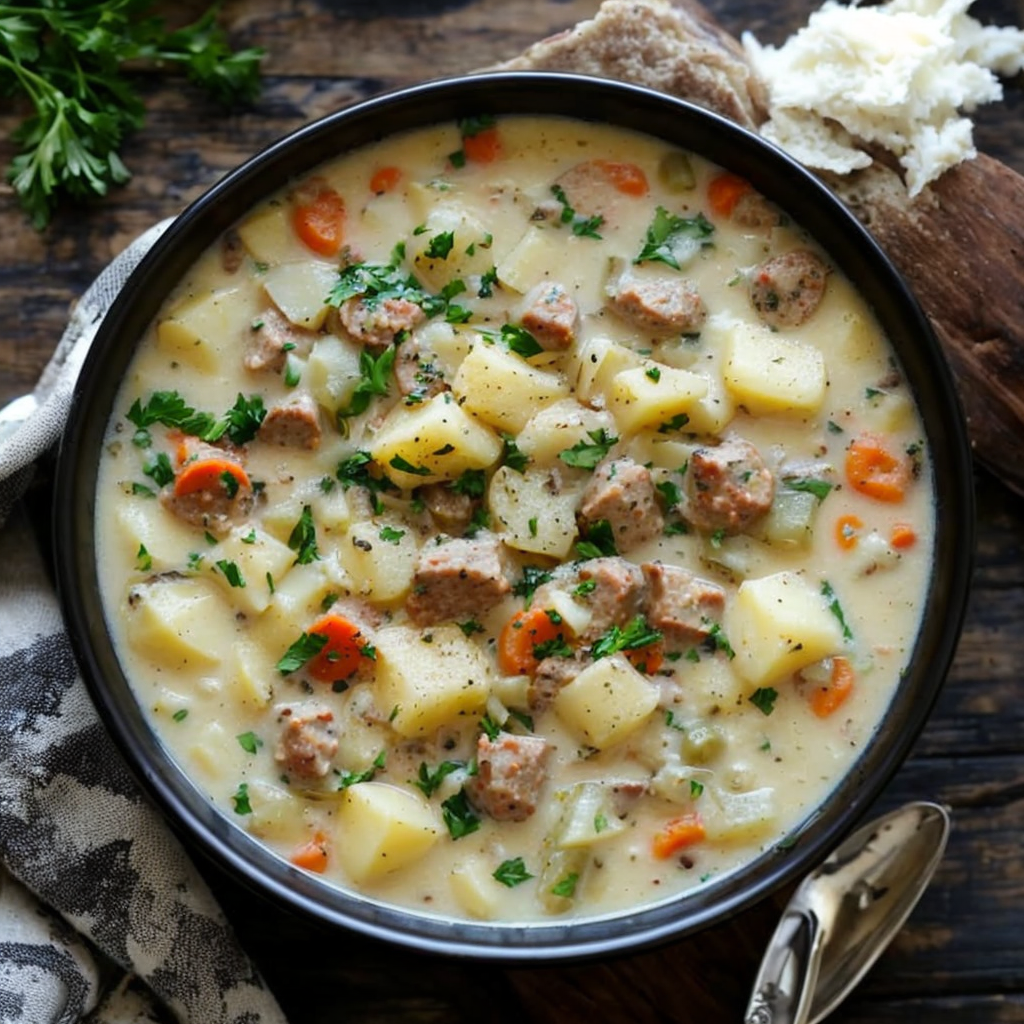Easy Potato and Sausage Chowder: A Comforting Dish in 30 Minutes
Imagine rolling into the colder months with a piping hot bowl of Easy Potato and Sausage Chowder that warms your soul. This effortless dish is a blend of hearty potatoes and savory sausage, creating a chowder that’s both rich and satisfying. Ready in just 30 minutes, it’s the perfect quick fix for a busy week’s meal and a gentle nudge towards comfort food without the kitchen marathon.
This chowder isn’t just a treat for your taste buds; it’s a whiff of hominess as it cooks. With just enough creaminess to feel indulgent, and simple staples that make it accessible to all, its robust flavors speak to both nostalgia and simplicity. Embrace the ease of putting together something delicious that doesn’t require hours over the stove but delivers a complex and comforting flavor. Whether you’re just warming up or entertaining guests, this recipe is poised to be a crowd-pleaser.
Quick Recipe Highlights
- Flavor Profile: A delightful blend of savory sausage with the creamy backdrop of potatoes, offering a touch of garlic and pepper that elevates the basic comfort of chowders.
- Texture: Soft chunks of potato lend a hearty bite amidst the silky, thickish broth, dotted with pieces of sausage for a pleasantly chewy contrast.
- Aroma: The aroma of sizzling sausage precedes a wave of comforting, creamy fragrances with subtle herbaceous notes.
- Visual Appeal: Delectable off-white cream with vibrant speckles of herbs and the rich appeal of sausage pieces make this dish a feast for the eyes.
- Skill Level Needed: Requires basic chopping and stirring skills; ideal for cooks of all levels, including beginners looking to impress with minimal effort.
- Special Equipment: A large pot will suffice, though a Dutch oven can enhance even heat distribution.
Recipe Overview
- Difficulty Level: Categorized as easy, this recipe demands minimal kitchen skills beyond essential cutting and stirring. It’s perfect for new cooks and experienced chefs looking for a quick meal.
- Category: Main course, primarily soups and stews that provide hearty nourishment with every serving.
- Cuisine: Rooted in American comfort food, it hints at European influences with its sausage and potato base.
- Cost: An economical choice, using highly accessible ingredients often found in pantry staples, costing roughly $15 for a family meal.
- Season: Most suited to fall and winter, offering warmth and comfort on chilly days.
- Occasion: Ideal for weeknight dinners, casual gatherings, or as the heartwarming centerpiece on a cold day.
Why You’ll Love This Recipe
The taste of Easy Potato and Sausage Chowder resonates deeply with those who enjoy home-style, rustic flavors. Every spoonful delivers a balanced punch of meaty sausage and tender potatoes, complemented by creamy textures—a winning combination paired with crusty bread or alone.
Convenience defines this recipe. Minimal prep time ensures that a delightful, satisfying meal can be made even on the busiest of weeknights. Have peace of mind knowing you can get from chopping board to dinner table in just half an hour.
Nutritionally, this chowder is rich in proteins courtesy of the sausage and provides fulfilling, slow-release energy from potatoes without being heavy. It’s a bowl that comforts and sustains, lacking the heaviness of more traditional cream-based soups.
From a social perspective, this dish holds a room together, giving your dining table a sense of gathering. Its aroma naturally draws guests as comforts of childhood and communal dining seem effortlessly brought back into focus.
Finally, in terms of economics, the accessibility of the ingredients means almost anyone can afford this luxurious-tasting, yet light-on-pocket dish. This chowder proves delicious meals can be made simply and affordably.
Historical Background and Cultural Significance
Chowders have long been regarded as a staple of New England cuisine, drawing from the maritime cultural heritage where hearty and nourishing meals were imperative. Sausages and potatoes were later additions, highlighting immigrant influences transforming traditional recipes to suit the available ingredients.
With sausage and potato frequently found in hearty, one-pot meals across Europe, their addition to American chowder offers a unique insight into the cultural blending that characterizes much of American culinary history. This chowder reflects years of adapting regional dishes through melting pot influences.
While variations abound across regions—with some swaps in herbs and broth bases—the evolution of the chowder speaks to innovation and adaptability, continually reflecting local flavors and preferences.
Regional spins include the addition of ingredients like bacon or corn, representing a blend of convenience and local abundance. Despite transformations, these chowders retain the charm and warmth of their original purpose: to nourish and satisfy.
Ingredient Deep Dive
**Potatoes**
Potatoes, known for their versatility, are a staple in many global cuisines. They carry historical significance as a dietary anchor through numerous cultures and eras, especially noted in early American, Irish, and Andean societies.
Nutritionally, potatoes offer a good source of complex carbohydrates, fiber, vitamins C and B6, and potassium. These nutrients advocate for lasting energy and contribute to cardiovascular health.
When selecting, opt for firm potatoes without blemishes. Store them in a cool, dark place, avoiding refrigeration as it can alter their starch content. Sweet potatoes can offer a slightly sweeter and more colorful alternative, though they will slightly change the dish’s character.
**Sausage**
Sausage, an ancient form of preserving and flavoring meat, carries cultural resonance with varying recipes worldwide. Its presence in this chowder adds depth and richness, redolent of familiar, comforting meals.
Rich in protein and fats, sausage also contributes iron and B vitamins, necessary for energy and metabolism. Precooked or freshly sliced, the choice of sausage adjusts flavor profiles dramatically—Italian for spice, or smoked for a rustic note.
Choose fresh sausages with a smooth casing, store them chilled, and consume promptly unless preserved. Turkey or chicken sausage could offer leaner yet flavorful variants for health-conscious alterations.
Common Mistakes to Avoid
- Avoid rushing the potatoes; undercooked potatoes will ruin the texture. Ensure they are fork-tender before proceeding to the final steps.
- Overcrowding the cooking vessel leads to uneven cooking. Keep ingredients manageable to let them cook evenly.
- Guard against burning by maintaining a gentle simmer rather than a rolling boil when cooking both potatoes and milk.
- Heavy seasoning adjustments must be avoided until the chowder is nearly complete to prevent oversalting. Add salt according to taste at the end.
- Using pre-shredded cheese when using cheese as garnish may release unwanted stabilizers and textures, leading to grainy results.
- Poor quality sausage can overpower the chowder. Select a sausage with reliable quality and flavor integrity.
- Failing to taste as you go means missed opportunities to adjust flavors for a harmonious dish.
- Skimming fat from sausage for leaner chowder alters depth; consider reducing sausage or using turkey sausage for fat content control.
Essential Techniques
**Sautéing Sausage**
Achieve a perfect browning on the sausage, unlocking not just taste but also intensifying aroma. Cook in batches if needed to prevent steaming in its juices—the goal is crispy edges and a slightly caramelized taste.
**Simmering the Chowder**
Keep heat at a medium-low to veer towards a simmer. This thoughtful temperature allows flavors to meld, the chowder to thicken gently, and prevents the milk from curdling, maintaining a creamy, unctuous texture.
Pro Tips for Perfect Easy Potato and Sausage Chowder
Use a mix of potatoes, combining russet and Yukon Gold, for a harmonious texture and flavor. The russets break down for creaminess while the Golds offer structure.
Crushed fennel seeds added to the sausage bring out sweeter undertones and enhance the overall flavor profile of the dish without overpowering.
Cook sausages in the same pot as you intend to simmer the chowder. This technique enables flavors to permeate the chowder without losing those delicious, rendered fats.
Reserve some cooked sausage to stir in at the end as a garnish, ensuring a contrast of flavors and textures in every bite.
Gradually fold in the milk or cream instead of pouring it all at once, avoiding curdling and maintaining a smooth consistency.
If serving later in the day, consider making the chowder a few hours ahead to let the flavors meld more comprehensively.
Variations and Adaptations
**Regional Variations**
Incorporate regional influences by adding sweet corn for a Midwestern twist, a nod to corn chowders of the region. New England fans might enjoy bits of clam added just before serving for a surf and turf effect.
**Seasonal Adaptations**
In spring, peas can add a burst of color and subtle sweetness, while autumn calls for some diced pumpkin or squash for a seasonal comforting twist.
**Dietary Modifications**
For healthier versions, substitute regular sausage with turkey or chicken counterparts, maintaining great flavor with less fat. Similarly, using cauliflower in place of potatoes undercuts carb content for keto or low-carb enthusiasts.
**Flavor Variations**
Add a sprig or two of rosemary for an herby note. Roasted red peppers can provide deeper color and additional layers of sweetness, balancing the umami in the sausage.
**Texture Modifications**
Blend a third of the chowder for a bisque-like smoothness while retaining chunks for body. A cornstarch slurry does wonders for those preferring a thicker, more velvety finish.
**Presentation Alternatives**
Serve in bread bowls for rustic charm or as part of a trio of soups for variety at larger gatherings. Garnish with fresh herbs like parsley or dill for an inviting visual appeal and crisp, fresh aroma.
Serving and Presentation Guide
Opt for wide, shallow bowls to showcase this chowder’s cozy components visually. Serve with a thick slice of toasted bread rubbed with garlic to enhance enjoyment.
Garnish each serving with fresh parsley leaves or chopped chives, a flourish of red pepper flakes for added heat, or even a pinch of shaved Parmesan for salty depth.
Traditional accompaniments include a side salad with a light vinaigrette, balancing the chowder’s richness with crisp contrast.
Serve hot but not scalding; ideal temperatures bring out each element’s nuance without risking mouth burns or rapid cooling.
Appropriate portion control maintains the chowder’s appeal when served at dinner parties or family gatherings, leaving room for guests to indulge in possibly more than one serving.
Wine and Beverage Pairing
Pair this chowder with a full-bodied Chardonnay whose buttery notes complement the creamy broth, while its acidity cuts through richness.
Non-alcoholic alternatives can include herbal teas such as chamomile or mint, offering aromatic refreshment. A ginger ale might provide a sweet, spicy match for the chowder’s savory nature.
For coffee lovers, a brewed dark roast with subtle spice or earthy tones complements the chowder, fostering warmth without overwhelming.
Wine should be served chilled between 50–60°F (10–15°C) to maintain crispness and acidity, enhancing the meal rather than overshadowing its warmth.
Storage and Shelf Life
Store leftovers in an airtight container in the refrigerator for up to three days. Reheat gently on the stovetop, adding a bit of additional milk or broth to restore the chowder’s creamy consistency.
Avoid metallic containers, which might derange the flavors over time. Opt for glass or BPA-free plastic to ensure taste integrity isn’t compromised.
Signs of spoilage include sour smell or separation; discard if such evidence appears. Keep tabs on the expiry date of sausage used; it dictates the entire chowder’s shelf life reliability.
Freezing isn’t optimal due to the cream content, but if necessary, remove potatoes and sausage before reheating, adding fresh when served.
Make Ahead Strategies
Prepare sausage and potatoes in advance, storing separately for an added freshness when assembled. Retain diced onions and garlic in airtight containers to mitigate aromatic absorption.
Assemble components up to a day in advance, stopping just before dairy is introduced; it’ll alleviate curdling risk, enriching flavors maximally.
Post-reheat, add a touch of fresh herbs to enhance presentation and aromatic brightness, counteracting the mellowing effect of storage.
Assemble with foresight, ensuring sausages are fully cooked to avoid flavor degradation and bacterial growth risks during refrigeration.
Reheat gently to avoid milk separation, using a low-and-slow heating technique that keeps flavors intact and the chowder just as enjoyable as it was fresh.
Scaling Instructions
When halving, reduce broth conservatively as reductions may uncover milk’s tendency to curdle; additional chicken broth will easily salvage consistency during adjustments.
For buffet-style dining or larger crowds, triple the recipe. Anticipate extended total cooking time, particularly as increasing volume lengthens heat distribution.
Employ larger pots or consider double batching to maintain quality and control. Plan for ample stirring to redistribute even heat across expanded volumes.
Storage considerations suggest dividing portions, preventing cross-flavor alterations carried by metallic containers, which can impede taste cohesion.
Nutritional Deep Dive
This chowder offers a balanced blend of macronutrients, with potatoes adding carbohydrates necessary for energy and sausage providing a wealth of proteins and fats.
Micronutrient uptake includes vitamins such as B6, C and essential minerals like potassium and iron. These are pivotal for metabolic efficiency and available on every spoonful.
Mind portion size to manage collagen impact while retaining a generous, comforting serving that modulates energy without overhauling calorie intake.
Dietary Adaptations
**Gluten-free**
Ensure broth base is certified gluten-free. All other components should naturally comply unless processed sausages incorporate flour or similar fillers.
**Dairy-free**
Swap out milk for unsweetened almond or oat milk. Coconut cream can create a likeness to traditional chowder flavor if lactose is to be avoided outright.
**Vegan**
Substitute sausage with plant-based alternatives. Consolidate with vegetable broth and coconut cream, capitalizing on mushrooms for additional texture and umami.
**Low-carb**
Use cauliflower instead of potatoes. Combine with chicken sausage or turkey, accommodating keto diets without sacrificing substantiality or convenience.
The Recipe
Easy Potato and Sausage Chowder
Serves: 4
Prep Time: 10 mins
Cook Time: 20 mins
Total Time: 30 mins
Kitchen Equipment Needed
- Large pot or Dutch oven
- Sharp knife
- Cutting board
- Wooden spoon
Ingredients
- 1 lb sausage, sliced
- 2 lbs potatoes, diced
- 1 onion, chopped
- 2 cloves garlic, minced
- 4 cups chicken broth
- 1 cup milk
- Salt and pepper to taste
- 1 tbsp olive oil
- Fresh parsley for garnish
Directions
- Heat the olive oil in a large pot over medium heat. Add sausage and cook until browned.
- Remove sausage and set aside, leaving drippings. Add onion and garlic, sautéing until onion becomes translucent.
- Add diced potatoes and chicken broth to the pot. Bring to a simmer and cook until potatoes are tender.
- Return sausage to the pot, followed by milk. Season with salt and pepper, stirring gently.
- Simmer for an additional 5 minutes, allowing flavors to meld.
- Serve hot, garnished with freshly chopped parsley.
Recipe Notes
- For a thicker chowder, mash some of the potatoes before adding milk.
- Customize with additional herbs or spices such as thyme or red pepper flakes.
Troubleshooting Guide
**Texture Issues**
If your chowder is too thin, mash some potatoes against the pot sides and simmer to thicken. A cornstarch slurry can instantly enhance thickness—mix 1 tablespoon cornstarch with 2 tablespoons water, add gradually, and simmer until the desired consistency is achieved.
**Ingredient Substitutions**
If sausage isn’t accessible, bacon lardons can replace its savory touch without deviating from the recipe’s fundamental allure.
Recipe Success Stories
Chez Judy tried adding bell peppers to this chowder and was delighted with the color and subtle sweetness added. Alex from Boston suggested Boudin Blanc to add a local touch, and Mara discovered a swirl of smoky paprika transformed this into a dinner party masterpiece.
Frequently Asked Questions
Freezing dairy-rich chowder is not recommended, as it can alter texture significantly. Opt instead to freeze potatoes and sausage separately, adding fresh milk upon reheating.
**What kind of sausage should I use?**
Choose quality sausage that suits your taste—sweet for mild flavors, hot for a spicier punch, or smoked for depth. The sausage type greatly influences the final taste.
**How can I avoid my milk from curdling?**
Incorporate milk gradually and avoid high heat, sticking to a gentle simmer. Non-dairy alternatives handle temperature fluctuations better without curdling.
Additional Resources
Dive deeper into chowder recipes with our New England Clam Chowder guide or explore ingredient versatility with our All About Potatoes article, which reveals tips on selection and storage for perfect results every time.
Join the Conversation
Share your Easy Potato and Sausage Chowder experiences and photos on social media using #ChowderDelight. Whether you’re trying a twist or sticking to tradition, your feedback and variations can inspire others yearning for a taste of comfort.



